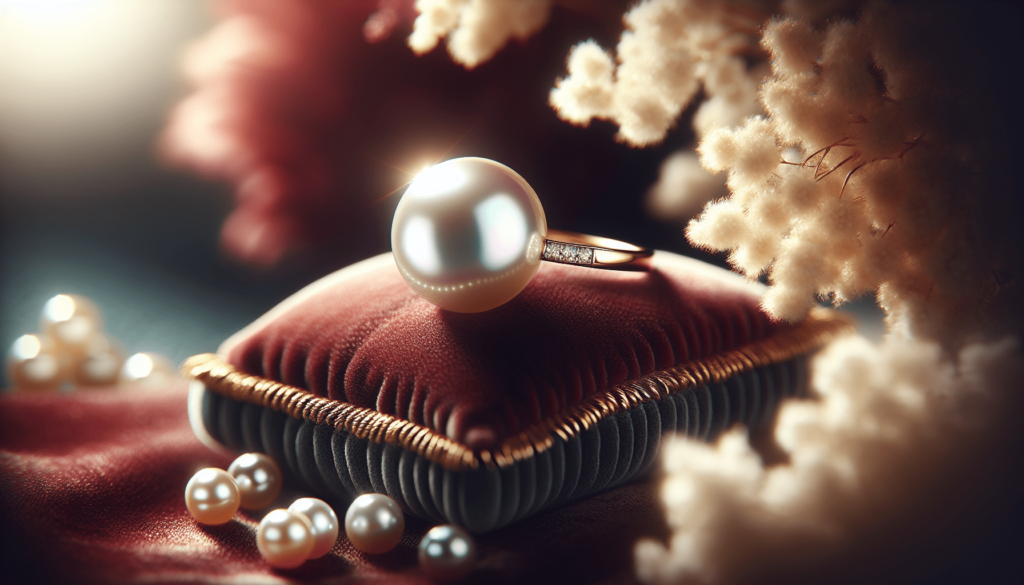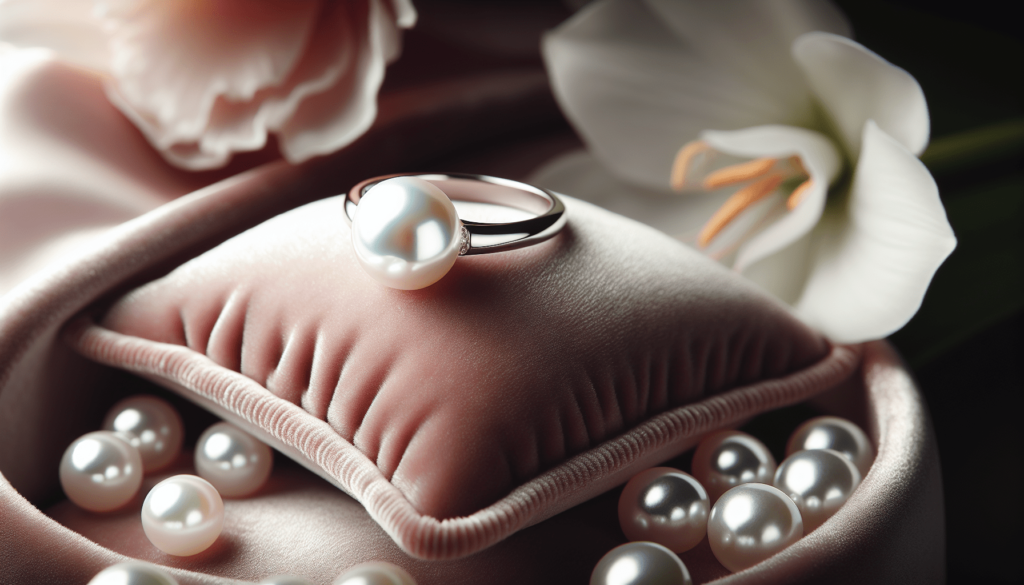So you’re interested in buying a pearl ring, but you’re not sure where to start? Look no further, because this article is here to guide you through the process. Whether you’re a complete beginner or just need a refresher, we’ve got you covered with all the essential tips and tricks you need to know before making your purchase. From understanding the different types of pearls to selecting the perfect ring setting, we’ll walk you through each step to ensure that you find the ideal pearl ring that suits your style and budget. Get ready to embark on your journey to becoming a pearl ring expert!

Find more products like these on Amazon!
Understanding Pearls
What are pearls?
Pearls are organic gems that are formed inside the shells of certain mollusks, such as oysters and mussels. They are created when a foreign object, like a grain of sand or a parasite, enters the shell and irritates the mollusk. In response, the mollusk secretes a substance called nacre, which forms around the foreign object in layers, eventually creating a pearl.
Types of pearls
There are various types of pearls, each with its own unique characteristics. Some of the most popular types include:
- Freshwater Pearls: These pearls are harvested from freshwater mussels and are known for their affordability and wide range of colors.
- Akoya Pearls: Known for their exceptional luster and classic appeal, Akoya pearls are primarily cultivated in Japan.
- South Sea Pearls: Larger and more valuable than many other types of pearls, South Sea pearls are cultivated in the waters of Australia, Indonesia, and the Philippines.
- Tahitian Pearls: Cultivated primarily in French Polynesia, Tahitian pearls are valued for their dark and exotic colors.
Natural vs. cultured pearls
Natural pearls are formed without any human intervention. They are extremely rare and command high prices in the market. On the other hand, cultured pearls are created with the help of human intervention, where a small bead or piece of tissue is inserted into the mollusk to stimulate the pearl formation process. Cultured pearls make up the majority of pearls available today.
Pearl quality factors
When choosing a pearl, it is important to consider its quality factors, which include:
- Color: Pearls come in a variety of colors, ranging from white and cream to pink, black, and even golden hues. The color should be consistent throughout the pearl.
- Size: Pearls can range in size from as small as 1 mm to as large as 20 mm. Larger pearls are typically more valuable.
- Shape: Pearls can be round, oval, drop-shaped, and various other shapes. Round pearls are considered the most desirable and valuable.
- Luster: Luster refers to the reflective quality of the pearl’s surface. Pearls with a high luster appear bright and glossy, while those with a low luster may appear dull.
Choosing the Right Pearl
Pearl color
The color of a pearl is an important consideration when choosing a pearl ring. The color should complement the wearer’s skin tone and personal style. White and cream-colored pearls are classic and versatile, while pink and lavender pearls add a touch of femininity. Black pearls, on the other hand, exude elegance and sophistication.
Pearl size
Pearl size is a matter of personal preference and budget. Larger pearls are often more valuable and can make a bold statement. However, smaller pearls can be just as beautiful and are often more affordable. It is important to consider the size of the wearer’s hand and their individual taste when choosing the size of the pearl.
Pearl shape
Pearls come in a variety of shapes, with round pearls being the most sought-after and valuable. Other popular shapes include oval, drop-shaped, and baroque (irregularly shaped) pearls. The shape of the pearl can impact the overall appearance and style of the ring, so it is essential to choose a shape that suits the wearer’s preferences.
Pearl luster
Luster refers to the shine and reflectivity of the pearl’s surface. High-quality pearls have a strong and radiant luster, while lower-quality pearls may appear dull or lackluster. When selecting a pearl ring, it is important to choose pearls with a bright and reflective luster, as it enhances their beauty and value.

Find more products like these on Amazon!
Selecting the Ring Setting
Metal type
The metal type of the ring setting plays a significant role in the overall style and durability of the ring. Common metal options for pearl rings include gold (yellow, white, or rose), silver, platinum, and even stainless steel. Each metal has its own unique qualities and price points, so it is essential to consider factors such as budget, durability, and personal preference when selecting the metal type.
Ring design
Pearl rings can come in a variety of designs, from simple solitaire settings to intricate halo or cocktail ring designs. The design of the ring should complement the pearl and enhance its beauty. Classic designs are timeless and versatile, while more contemporary or unique designs can make a bold fashion statement.
Prong setting vs. bezel setting
Prong settings and bezel settings are the two most common ways to secure a pearl in a ring. Prong settings use small metal prongs to hold the pearl in place, allowing more light to pass through the pearl and enhancing its luster. Bezels, on the other hand, fully encircle the pearl with a metal rim, providing a more secure and protective setting. The choice between prong and bezel setting depends on personal preference and the desired look of the ring.
Considering the wearer’s style
When choosing a ring setting, it is important to consider the personal style and preferences of the wearer. Some individuals may prefer a more classic and understated design, while others may gravitate towards a more bold and statement-making style. By considering the wearer’s style, you can select a ring setting that they will love and feel confident wearing.
Determining the Ring Size
Methods for measuring ring size
Determining the ring size is crucial to ensure a proper fit and comfortable wear. There are various methods for measuring ring size, including:
- Using a ring sizer: A ring sizer is a small tool with marked sizes that can be slipped onto the finger to determine the correct size.
- Measuring the circumference: Using a measuring tape or a piece of string, wrap it around the finger and measure the circumference. Compare the measurement to a ring size chart to find the corresponding size.
- Using a ring that already fits: If the intended wearer already has a ring that fits well on the desired finger, you can measure the inner diameter of the ring to determine the size.
Using a ring sizer
Using a ring sizer is one of the easiest and most accurate ways to determine ring size. It is a small tool that typically consists of a set of metal rings in various sizes. The wearer can try on different rings until they find the one that fits comfortably. It is important to ensure that the ring sizer is used on the intended finger for the pearl ring.
Consulting a jeweler
For a more precise measurement, it is recommended to consult a professional jeweler. They have specialized tools and expertise to accurately measure ring size. A jeweler can provide guidance and help determine the correct ring size based on the intended finger and the desired fit of the ring.

Setting a Budget
Understanding the factors affecting pearl ring prices
Several factors can influence the price of a pearl ring, including:
- Pearl quality: High-quality pearls with desirable characteristics, such as a round shape, high luster, and minimal blemishes, tend to be more expensive.
- Pearl type: Different types of pearls have varying levels of rarity and value. For example, South Sea pearls and natural pearls are generally more expensive than freshwater pearls or cultured pearls.
- Metal type: The type of metal used in the ring setting can also impact the price. Precious metals like gold and platinum are typically pricier than silver or stainless steel.
- Design complexity: More intricate and elaborate designs may require additional craftsmanship and labor, ultimately increasing the cost of the ring.
Setting a realistic budget
Before starting your search for a pearl ring, it is important to set a realistic budget. Consider your personal financial situation and determine how much you are willing to spend on the ring. By setting a budget, you can narrow down your options and focus on finding a pearl ring that fits both your preferences and your financial constraints.
Choosing the Right Jewelry Store
Researching reputable jewelry stores
When purchasing a pearl ring, it is crucial to choose a reputable jewelry store that offers genuine and high-quality products. Take the time to research different jewelry stores and read reviews from previous customers to gain insights into their reputation and reliability. Look for stores that have experience in selling pearls and have a strong track record in the industry.
Reading customer reviews
Customer reviews can provide valuable information about the quality of products, customer service, and overall shopping experience offered by a jewelry store. Take the time to read both positive and negative reviews to get a comprehensive understanding of the store’s reputation. Look for stores that have numerous positive reviews and satisfied customers.
Examining store policies
Before making a purchase, carefully review the store’s policies regarding returns, exchanges, and warranties. Pay attention to the duration of the return period, any restocking fees, and the conditions for a full refund. Understanding the store’s policies will give you peace of mind and ensure that you can make an informed decision.
Considering additional services
Some jewelry stores may offer additional services, such as free resizing, cleaning and maintenance, or appraisal services. These services can add value to your purchase and make the overall shopping experience more convenient. Consider whether these additional services are important to you and factor them into your decision-making process.

Ensuring Quality and Authenticity
Identifying fake pearls
Fake pearls can sometimes be difficult to distinguish from genuine pearls, especially for beginners. However, there are a few telltale signs that can help you identify fake pearls. Fake pearls are often lightweight and may have a uniform and artificial appearance. They may also have a plastic-like surface or feel. It is essential to purchase from reputable jewelers to ensure that you are buying genuine pearls.
Checking for proper certification
Genuine pearls often come with certifications or grading reports that authenticate their quality and origins. These certifications are typically issued by gemological laboratories and provide valuable information about the pearl’s characteristics, such as size, shape, color, luster, and any treatments or enhancements that may have been applied. When purchasing a pearl ring, inquire about any available certifications to ensure the quality and authenticity of the pearls.
Verifying pearl quality
To verify the quality of pearls, there are a few key factors to consider:
- Color: Look for pearls with a consistent and attractive color. High-quality pearls often have a soft glow and a slight iridescence.
- Luster: Assess the reflective quality of the pearls. High-quality pearls have a strong, mirror-like luster that is captivating.
- Surface quality: Examine the surface of the pearls for any blemishes, spots, or irregularities. Higher-quality pearls have minimal imperfections.
- Size and shape: Evaluate the size and shape of the pearls, ensuring they meet your preferences and match the intended design of the ring.
Considering Maintenance and Durability
Understanding pearl care guidelines
Pearls are delicate gemstones that require special care to ensure their longevity and beauty. Some general care guidelines for pearls include:
- Avoid exposure to chemicals, such as perfume, hairspray, and cosmetics, as they can damage the pearls.
- Clean pearls gently with a soft, damp cloth or a mild soap solution.
- Store pearls separately from other jewelry to avoid scratching or tangling.
- Avoid exposing pearls to extreme temperatures or prolonged sunlight.
Considering the delicacy of pearls
Pearls are organic gemstones that are susceptible to damage if not handled with care. They are softer and more fragile compared to other gemstones, such as diamonds or sapphires. When wearing a pearl ring, it is important to be mindful of activities that may expose the pearls to potential damage or impact. Remove the ring when engaging in activities that may cause the pearls to come into contact with hard surfaces or chemicals.
Evaluating the durability of the ring setting
While pearls themselves are delicate, the durability of the ring setting can provide additional protection and longevity to the overall ring. Consider the durability of the metal type chosen for the ring, as well as the craftsmanship and quality of the setting. A well-made and sturdy setting will help ensure that the pearls are securely held in place and reduce the risk of damage or loss.

Exploring Different Styles and Designs
Classic pearl solitaire ring
A classic pearl solitaire ring features a single pearl set onto a metal band. This timeless design highlights the beauty and elegance of the pearl, making it a popular choice for those who prefer a simple and understated look. The solitaire design allows the pearl to take center stage, creating a sophisticated and refined ring.
Modern pearl halo ring
A modern pearl halo ring features a central pearl that is surrounded by smaller diamonds or gemstones, creating a halo effect. This design adds a touch of sparkle and enhances the overall beauty of the pearl. The halo design is popular among those looking for a more contemporary and glamorous look.
Vintage-inspired pearl cocktail ring
A vintage-inspired pearl cocktail ring often incorporates intricate filigree or engraved details, reminiscent of past eras. These rings exude a sense of nostalgia and charm, perfect for those who appreciate vintage aesthetics. The elaborate design of a cocktail ring allows for creativity and a unique expression of personal style.
Contemporary pearl bypass ring
A contemporary pearl bypass ring features a design where the band wraps around the finger and crosses over itself, creating a visually interesting and modern look. This style adds a sense of movement and uniqueness to the ring. Bypass rings often feature pearls on either end of the crossover, adding a touch of elegance to the design.
Understanding Return and Warranty Policies
Reading the fine print
Before making a purchase, carefully read and understand the store’s return and warranty policies. Pay attention to any specific conditions or limitations mentioned in the fine print. Familiarize yourself with the timeframe for returns or exchanges, any restocking fees, and the requirements for eligibility.
Knowing the return policy
A clear understanding of the return policy is crucial in case the pearl ring does not meet your expectations or requires any alterations or adjustments. Ensure that the return policy provides an adequate timeframe for you to inspect and evaluate the ring after purchase. Also, consider if the return policy includes a full refund, exchange, or store credit.
Understanding warranty coverage
Some jewelry stores offer warranties or guarantees on their products to protect against any manufacturing defects or damages that may occur over time. Familiarize yourself with the warranty coverage, including the duration, any limitations or exclusions, and the process for making a claim. A comprehensive warranty can provide peace of mind and protect your investment in the pearl ring.




